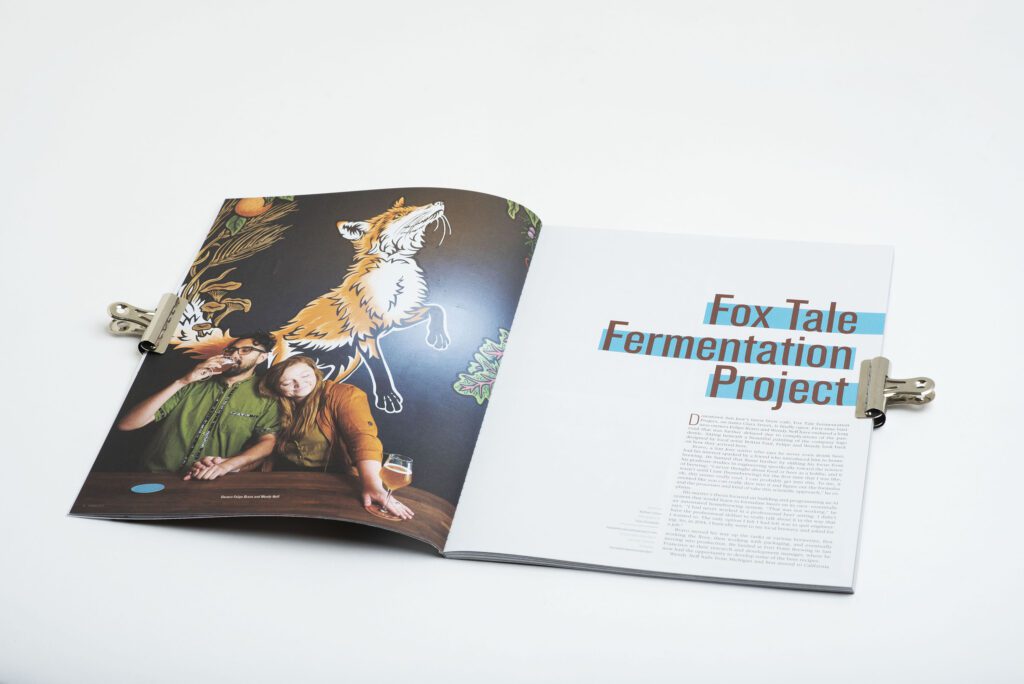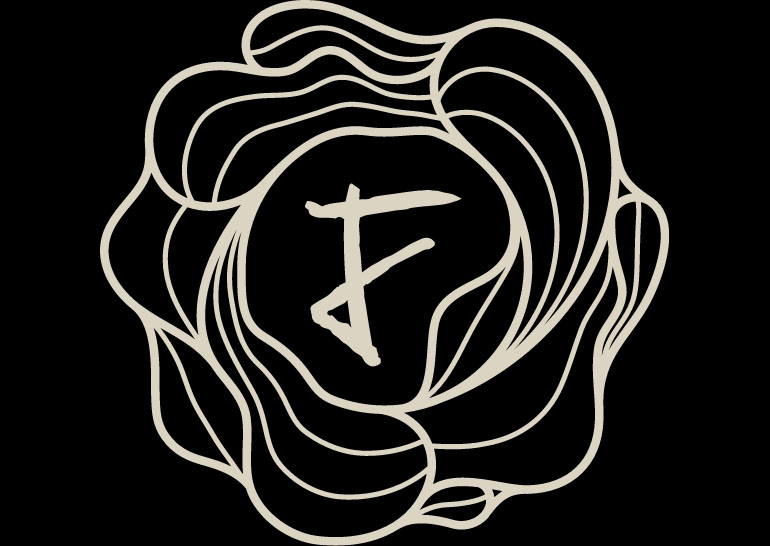
“We’ve been so fortunate to have connections and relationships and the goodwill of people around us.”
-Wendy Neff
Downtown San Jose’s latest brew café, Fox Tale Fermentation Project, on Santa Clara Street, is finally open. First-time business owners Felipe Bravo and Wendy Neff have endured a long road that was further delayed due to complications of the pandemic. Sitting beneath a beautiful painting of the company logo designed by local artist Brittni Paul, Felipe and Wendy look back on how they arrived here.
Bravo, a San Jose native who says he never even drank beer, had his interest sparked by a friend who introduced him to homebrewing. He fanned that flame further by shifting his focus from his graduate studies in engineering specifically toward the science of brewing: “I never thought about food or beer as a hobby, and it wasn’t until I saw [homebrewing] for the first time that I was like, oh, this seems really cool. I can probably get into this. To me, it seemed like you can really dive into it and figure out the formulas and the processes and kind of take this scientific approach,” he explains.
His master’s thesis focused on building and programming an AI system that would learn to formulate beers on its own—essentially an automated homebrewing system. “That was not working,” he says. “I had never worked in a professional beer setting. I didn’t have the professional skillset to really talk about it in the way that I wanted to. The only option I felt I had left was to quit engineering. So, in 2014, I basically went to my local brewery and asked for a job.”
Bravo moved his way up the ranks at various breweries, first working the floor, then working with packaging, and eventually moving into production. He landed at Fort Point Brewing in San Francisco as their research and development manager, where he now had the opportunity to develop some of the beer recipes.
at age 18, essentially on a whim she says, but would return home a few years later for a life reset. While home, she got a job at the Brinery in Ann Arbor, famous for their fermented products such as sauerkraut and kimchi. It was a short-lived but instrumental gig, as it sparked a passion of her own.
“I really fell in love with fermentation,” she says. “Then when I came back to California, it just stuck a whole lot more.” She landed a job at Facebook on their superfoods team, making “really amazing, unique dishes that were raw and vegan and gluten-free” to serve in their on-site restaurants. “It exploded my whole desire to help people get interesting foods and ingredients and unique flavors. [They] let me create my own fermentation program, which they had never done before. So, then I had three years of experimenting and going wild with it as much as I wanted to.”
Fermentation, whether it be with alcohol or food, is part of humanity’s long and storied history. The process of combining food preservation with exploration of flavor has created a rich history that overlaps with the development of cultures around the world. The yeasts that turn grains into beer and cabbage into sauerkraut are not so different, and modern techniques have accelerated innovation and subsequent overlap in the fields of both food and alcohol.
When Bravo and Neff met, this overlap resulted in an immediate burst of creative energy as the two batted around ideas for sour beers using pickle brine and other unusual combinations of ingredients, imagining what sorts of flavors they might produce. They also discovered that they both harbored a dream to open a space where they could build community through their fermented creations.
As the two came up with projects to experiment with together, their relationship grew as well. They started making limited runs of beers using things like mushrooms, beets, radishes, and flow-
ers, which they fine-tuned and shared with friends and local beer enthusiasts. They named their venture Fox Tale, a whimsical reference to the stories that can be found behind each collaboration.
The next step was to open their dream space, but opening during COVID was “the hardest thing I’ve ever done, for sure,” Neff says. “We’ve been so fortunate to have connections and relationships and the goodwill of people around us.”
The small space is cozy and inviting, decorated with a rotating collection of art from local artists. They serve small bites that highlight the ferments, keeping things simple so as to remain approachable. They offer a mocktail and kombucha as nonalcoholic options and hope to offer classes on fermenting and homebrewing. They want their patrons to feel welcome, and more importantly, like part of the story. And as for what’s on tap: it’s not all pickle brine and mushroom beer.
“Taking twists on familiar things is a big part of what we want to do,” Bravo explains. The menu still offers recognizable styles like IPA and lager. “It’s a little different, [but] it’s not crazy blending these concepts that are unique and pique people’s interests, trying to redefine what those styles mean and create something new.”
Though market saturation and the pandemic have been tough on small beermakers, these two entrepreneurs are taking on the challenge. They understand that support from the San Jose community will be key, and have already built much of the foundation while eager to continue earning that support. And as they talk, new ideas keep springing up—the creative energy has not subsided.
“The business is an extension of us,” says Bravo. “The goal is to incorporate as many people into this project as we can. It’s not just us. We’re always going to be putting it back into the community. We’re not totally on our own.”
foxtalefermentationproject.com
Instagram: foxtalefermentationproject
